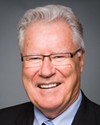I'm quoting off the top of my head. There is a certain suite of sensors that we advocate should be there that would help in search and rescue, that the aircraft be able to operate from unprepared gravel runways, that it be able to operate in icy conditions, and that it have a ramp. We felt the ramp was essential and extremely important. Those are just examples. I may have left something out, but there is a list right at the beginning of the report that lists all the mandatories that we identified that were not part of the original specifications.
Evidence of meeting #48 for National Defence in the 40th Parliament, 3rd Session. (The original version is on Parliament’s site, as are the minutes.) The winning word was report.
A recording is available from Parliament.




